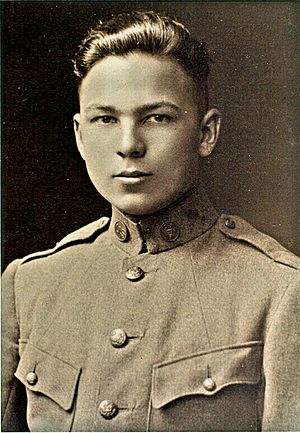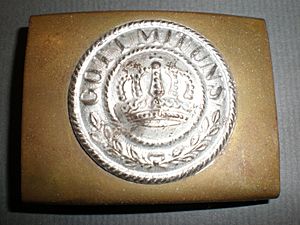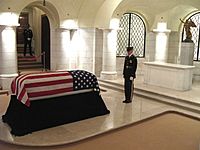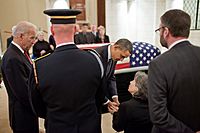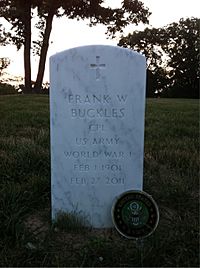Frank Buckles facts for kids
Quick facts for kids
Frank Buckles
|
|
|---|---|

Buckles on March 6, 2008
|
|
| Birth name | Wood Buckles |
| Born | February 1, 1901 Bethany, Missouri, U.S. |
| Died | February 27, 2011 (aged 110 years, 26 days) Charles Town, West Virginia, U.S. |
| Buried | |
| Allegiance | |
| Service/ |
|
| Years of service | August 1917 – November 1919 |
| Rank | |
| Service number | 15577 |
| Unit | 1st Fort Riley Casual Detachment |
| Battles/wars | World War I (soldier) World War II (civilian POW)
|
| Awards | |
| Spouse(s) |
Audrey Mayo
(m. 1946; died 1999) |
| Children | 1 |
| Relations | Susannah Buckles Flanagan James C. Buckles (father) Theresa J. Buckles (mother) |
| Signature | |
Frank Woodruff Buckles (born Wood Buckles, February 1, 1901 – February 27, 2011) was a United States Army corporal. He was the last known American soldier who fought in World War I. He joined the U.S. Army in 1917 when he was 16 years old. He drove ambulances and motorcycles near the front lines in Europe.
Later, during World War II, he was captured by Japanese forces. He was working in the shipping business at the time. He spent three years as a civilian prisoner in the Philippines. After the war, Buckles got married and moved to a farm in Charles Town, West Virginia. He continued to work on his farm until he was 105 years old. He lived to be 110 years old.
In his final years, Frank Buckles worked to create a memorial in Washington, D.C. This memorial would honor those who served in World War I. He spoke to the U.S. Congress and met with President George W. Bush to support this idea.
Buckles received several awards for his service. These included the World War I Victory Medal and the French Legion of Honor. His funeral was held at Arlington National Cemetery with full military honors. President Barack Obama paid his respects before the ceremony.
Contents
Frank Buckles' Early Life
Frank Buckles was born on February 1, 1901, in Bethany, Missouri. His parents were James Clark Buckles and Theresa J. Buckles. He had two older brothers and two older sisters. Many people in his family lived for a very long time. His grandfather was born in 1817, and his father lived to be 94.
When Frank was young, he was known as Wood. In 1903, he and his brother Ashman got scarlet fever. Frank survived, but Ashman died from the illness. Frank went to school in Walker, Missouri, and later in Oakwood, Oklahoma. He also worked at a bank. He enjoyed reading newspapers and was an amateur wireless operator.
Serving in World War I
Five months after the United States joined World War I, Frank Buckles wanted to enlist. He tried to join the Marines but was too small. The Navy turned him down because they said he had flat feet. However, the Army accepted him. Even though he was only 16, he looked older. A sergeant suggested he add a middle initial, so he used his uncle's name, "Frank Woodruff Buckles." Another sergeant told him that driving ambulances was the fastest way to the front lines.
Frank Buckles joined the Army on August 14, 1917. He trained at Fort Riley in Kansas. Later that year, he sailed to Europe on the RMS Carpathia. This ship was famous for rescuing survivors of the Titanic in 1912. During the war, Buckles drove ambulances and motorcycles. He served with the Army's 1st Fort Riley Casual Detachment in England and then France.
Buckles saw how the war affected children in France. He remembered helping to feed them. After the war ended in 1918, he escorted prisoners of war back to Germany. One German prisoner gave him a belt buckle that said "Gott mit uns" (English: God with us). He kept this buckle his whole life. Buckles was promoted to corporal on September 22, 1919. He was honorably discharged in November 1919 and returned to the United States.
Life Between the Wars
After World War I, Frank Buckles attended the opening of the Liberty Memorial in Kansas City, Missouri. This memorial honored Americans who died in the war. There, he met General of the Armies John J. Pershing, who led American forces in Europe.
Buckles then went to business school in Oklahoma City. He found work at a shipping company in Toronto, Ontario, Canada. From 1922 to 1923, he served in the New York National Guard in New York City. He also worked in financial services there.
He then became a chief purser on cargo and passenger ships. He traveled to South America, Europe, and Asia. In the 1930s, he heard German and British passengers express fears about the Nazis. Military officers told him that Germany was preparing for war. Buckles saw unfair treatment of people in Germany. He warned friends there that their country would be harmed by Adolf Hitler. He even met Hitler at a German hotel. During the Great Depression, he sent money to his father, who was a struggling farmer in Oklahoma.
World War II and Later Life

In 1940, Frank Buckles was working for shipping companies. His job took him to Manila in the Philippines. When World War II started in the Pacific, he stayed in Manila to help supply U.S. troops. In January 1942, Japanese forces captured him. He spent three years and two months as a civilian prisoner. He was held in the Santo Tomas and Los Baños prison camps.
As a prisoner, he faced starvation. He received only a small meal of mush in a tin cup, which he kept his whole life. He weighed less than 100 pounds and developed beriberi, a disease caused by lack of vitamins. He led other prisoners in exercises to stay healthy. His captors were not kind, but Buckles was allowed to grow a small garden. He often used its produce to help feed the children in the camp.
All the prisoners were freed on February 23, 1945, after a raid by Allied forces. Before the war, Buckles spoke German, Spanish, Portuguese, and French. By the end of the war, he had also learned some Japanese.
After World War II, Buckles moved to San Francisco. He married Audrey Mayo in 1946. Eight years later, they bought a 330-acre farm called Gap View Farm in West Virginia. They raised cattle there. In 1955, their only child, Susannah, was born. Buckles, who had traveled the world, settled down to farm life. He also became involved in the county historical society. Audrey Buckles died in 1999. Their daughter moved back to the farm to care for him.
A Long and Active Life
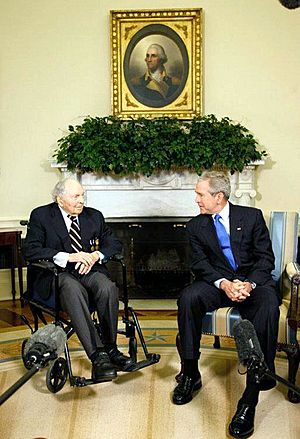
After the year 2000, Frank Buckles continued to live near Charles Town, West Virginia. He was still driving a tractor on his farm at age 103. In an interview in 2007, he said the United States should only go to war "unless it's an emergency." He also said, "If your country needs you, you should be right there."
When asked the secret to a long life, Buckles said being hopeful and not rushing were important. He added, "When you start to die ... don't." In another interview, he mentioned genetics, exercise, and a healthy diet. But he said "the will to survive" was most important.
In 2007, Buckles joined actor Gary Sinise to lead a Memorial Day parade. That evening, his life story was shown on NBC Nightly News. In February 2008, after the death of Harry Richard Landis, Frank Buckles became the last surviving American veteran of World War I. The next month, he met with President George W. Bush at the White House. He also visited wounded soldiers at Walter Reed Army Medical Center.
Buckles was the Honorary Chairman of the World War I Memorial Foundation. This group worked to make the District of Columbia War Memorial the National World War I Memorial. He was named ABC's World News Tonight "Person of the Week" in March 2009. This was for his efforts to create the memorial. He even spoke to Congress on December 3, 2009. He was the oldest person ever to testify before Congress.
Frank Buckles was a Freemason and a Shriner. He was a member of the Osiris Shriners of Wheeling, West Virginia. He became "the oldest Shriner in Shrinedom." He was also interested in his family history. He was a member of the West Virginia Society of the Sons of the American Revolution since 1935.
On February 1, 2010, Buckles' 109th birthday, a documentary about him was announced. It was called "Pershing's Last Patriot." In late 2010, Buckles was still giving interviews. He became a supercentenarian on his 110th birthday, February 1, 2011.
Frank Buckles died of natural causes at his home on February 27, 2011. He was 110 years and 26 days old.
Remembering Frank Buckles
Frank Buckles usually would not have qualified for burial at Arlington National Cemetery. This is because he had never been in combat. However, his friends and family got special permission from the government in 2008. Ross Perot, who had met Buckles, helped with this.
When Buckles died, President Barack Obama ordered that the American flag be flown at half-staff. This was done on all government buildings on the day Buckles was buried. The governors of 16 states also lowered their state flags.
The United States Senate passed a resolution on March 3, 2011. It honored "the last veteran to represent the extraordinary legacy of the World War I veterans." There was a plan for Buckles to lie in honor in the United States Capitol rotunda. However, this plan was not approved. Instead, a ceremony was held at the Arlington Memorial Amphitheater.
On March 8, 2011, students and teachers at Buckles' high school in Missouri honored him. His church in Charles Town held a memorial service. On March 12, 2011, a ceremony was held at the Liberty Memorial in Kansas City, Missouri. This honored Buckles and the "passing of the Great War generation."
A ceremony took place at Arlington National Cemetery's Memorial Amphitheater Chapel on March 15. President Barack Obama and Vice President Joe Biden attended and met with the family. Buckles' flag-draped coffin was carried to his burial plot on a horse-drawn caisson. The folded flag was given to his daughter. Buckles was buried with full military honors near General of the Armies John J. Pershing.
In Martinsburg, West Virginia, a candlelight vigil was held for Buckles. Donations were collected for a statue of him in Charles Town.
Frank Buckles was the last U.S. veteran of World War I. He was also the oldest World War I veteran in the world when he died. After his death, two other World War I veterans were still alive: Florence Green and Claude Choules. They both served in the British Armed Forces.
Awards and Recognition
For his service in World War I, Frank Buckles received the World War I Victory Medal. He also received four Overseas Service Bars. He also qualified for the Army of Occupation of Germany Medal for his service in Europe after the war. He received this medal after it was created in 1941.
Buckles was very involved with the Jefferson County Historical Society in West Virginia. He was even president from 1960 to 1964. In 1981, he was given the honor of Emeritus Officer by the organization.
In 1999, the French president Jacques Chirac gave him France's Legion of Honour. This was for his service during World War I.
In 2007, the Library of Congress included Buckles in its Veterans History Project. He gave three oral history interviews when he was 100, 103, and 107 years old. You can find information about his experiences in both world wars from this project.
In 2008, a part of West Virginia Route 9 near his farm was named in his honor. This was done by West Virginia Governor Joe Manchin. The next month, Buckles received the Veterans of Foreign Wars' Gold Medal of Merit. He also had his portrait painted for the National World War I Museum.
In April 2021, Frank Buckles' wish for a World War I memorial in Washington, D.C. came true. A plan by Joseph Weishaar was approved. On April 16, 2021, the memorial was officially opened. There was a flag-raising ceremony and remarks from President Joe Biden. Actor Gary Sinise hosted the event. The ceremony was smaller due to the COVID-19 pandemic. It later opened to the public.
See also
 In Spanish: Frank Buckles para niños
In Spanish: Frank Buckles para niños
- List of last surviving World War I veterans
- List of ambulance drivers during World War I
- Last surviving United States war veterans


